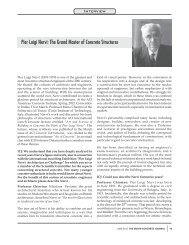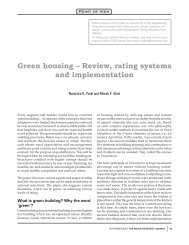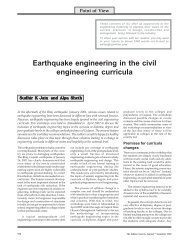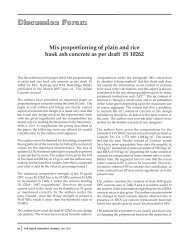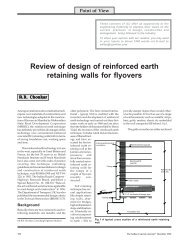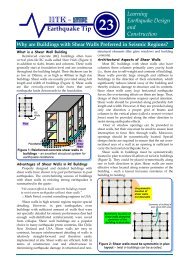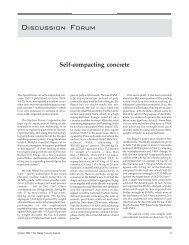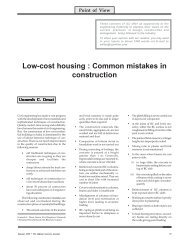Download - The Indian Concrete Journal
Download - The Indian Concrete Journal
Download - The Indian Concrete Journal
You also want an ePaper? Increase the reach of your titles
YUMPU automatically turns print PDFs into web optimized ePapers that Google loves.
‘pozzolan’ as is appropriate. Pozzolan<br />
is siliceous or siliceous and aluminous<br />
material, which itself possesses little or<br />
no cementitious value but will, in finely<br />
divided form and in the presence of<br />
moisture, chemically react with calcium<br />
hydroxide at ordinary temperatures to<br />
form compounds possessing<br />
cementious properties.<br />
Mineral admixtures may be reactive<br />
or inactive in terms of cement<br />
hydration. Pozzolans or cementitious<br />
materials are reactive mineral<br />
admixtures, while finely divided<br />
aggregates are inactive. IS 3812 : 2003<br />
allows the use of fly ash in concrete both<br />
as pozzolana (Part-I) and mineral<br />
admixture (Part-II). Both the parts of<br />
IS 3812 : 2003 specify detailed<br />
requirements on physical and chemical<br />
characteristics of fly ash. Amongst<br />
these, two requirements, the one on loss<br />
of ignition and the other one on the<br />
fineness are important. Requirement on<br />
LOI has significant bearing on<br />
durability, higher LOI could impede<br />
durability. <strong>The</strong>refore, strict adherence<br />
to the requirement of LOI (5 percent) is<br />
very important. Fineness has influence<br />
on improving strength and also<br />
durability.<br />
IS 3812 : 2003 specifies 34 percent<br />
retention of particles coarser than 45 μ<br />
in case of fly ash used as pozzolanic<br />
material (Part-I) and 50 percent<br />
retention for its use as mineral<br />
admixture (Part-II). Additionally, the<br />
standard also specifies the average<br />
fineness requirement as 320 m 2 /kg for<br />
the use as pozzolana (Part – I) and<br />
200 m 2 /kg for admixture. Contribution<br />
of particles coarser than 45 μ to<br />
secondary hydration by means of<br />
pozzolanic reaction is not significant.<br />
<strong>The</strong>ir incorporation in concrete mix may<br />
be viewed as replacement of sand.<br />
<strong>The</strong>refore, particle size of 45 μ or less is<br />
more important for pozzolanic action<br />
than the average fineness of fly ash.<br />
ASTM C618-03 and Japanese code JISA<br />
6201-99 do not specify the requirement<br />
on average fineness 13,16 . This<br />
requirement should be deleted from IS<br />
3812 : 2003, otherwise it may create<br />
confusion.<br />
Mix proportioning<br />
<strong>The</strong>re is a school of thought which<br />
subscribes to the view that IS codes do<br />
Point of View<br />
not allow more than 35 percent of fly<br />
ash in concrete. No IS code limits the<br />
quantity of fly ash to be used either as<br />
pozzolana or mineral admixture for<br />
replacement of OPC in proportioning<br />
the mix for structural concrete.<br />
However, IS 1489 (Part I) : 1991 specifies<br />
35 percent as the upper limit of fly ash<br />
for blended cement, (Portland<br />
pozzolanic cement) 17 . <strong>The</strong> confusion<br />
might have originated from the footnote<br />
of Table 5 of IS 456 13 . <strong>The</strong> first footnote<br />
of the table states,<br />
“Cement content prescribed in<br />
this table is irrespective of the<br />
grades of cement and it is<br />
inclusive of additions mentioned<br />
in 5.2. <strong>The</strong> additions such as fly<br />
ash or ground granulated blast<br />
furnace slag may be taken into<br />
account in the concrete<br />
composition with respect to the<br />
cement content and water –<br />
cement ratio if the suitability is<br />
established and as long as the<br />
maximum amounts taken into<br />
account do not exceed the limit<br />
of pozzolana and slag specified<br />
in IS 1489 (Part-I) and IS 455,<br />
respectively” 17 .<br />
Intent of the footnote is only related<br />
to determination of the minimum<br />
cement content, maximum watercement<br />
ratio and minimum grade of<br />
concrete for different exposures with<br />
normal weight aggregates of 20 mm<br />
nominal maximum size. As per this<br />
footnote, contribution of fly ash should<br />
not be taken more than 35 percent of the<br />
total cement content (binder: OPC + fly<br />
ash) in calculating the minimum cement<br />
content when CRL by fly ash is more<br />
than 35 percent. For example, in case of<br />
severe exposure condition, minimum<br />
grade of concrete and corresponding<br />
minimum cement content specified in<br />
Table 5, IS 456 is M30 and 320 kg/m 3 ,<br />
respectively 13 . If HVFAC mix is to be<br />
proportioned with CRL of 50 percent by<br />
fly ash, then binder (OPC + fly ash)<br />
content of 377.00 kg/m 3 is required to<br />
satisfy the minimum requirement of 320<br />
kg/m 3 cement (OPC: 0.5 x 377.00 + fly<br />
ash: 0.35 x 377.0).<br />
Another important aspect<br />
associated with mix<br />
proportioning is fixation of<br />
target strength. In this context,<br />
clause 4.9.2.2 of IS 456 specifies<br />
the following 15 :<br />
“<strong>The</strong> mix shall be designed to<br />
produce the grade of concrete having<br />
the required workability and<br />
characteristic strength not less than<br />
appropriate values given in Table 2. <strong>The</strong><br />
target mean strength of concrete mix<br />
should be equal to the characteristic<br />
strength plus 1.65 times the standard<br />
deviation”. 13<br />
Requirement of the first part is<br />
related to the acceptance criteria and<br />
needs to be adhered to for all types of<br />
concrete mix whether it is produced by<br />
hand mixing or through highly<br />
mechanised batching plant having<br />
high-speed mixer. <strong>The</strong> second part is<br />
desirable if hand mixing or other means<br />
is resorted to for production of concrete<br />
where higher uncertainties exist in<br />
achieving at site the same properties as<br />
determined at laboratory from trial<br />
mixes. But, this requirement is<br />
completely unnecessary when batching<br />
plant with high-speed mixer at site or<br />
ready mix concrete (RMC) is used.<br />
Canadian code A23.1-04 does not<br />
specify such requirements 18 . Experience<br />
shows concrete mix produced by highspeed<br />
mixer exhibit better properties<br />
than that of trial mixes conducted at<br />
laboratory. Application of this clause,<br />
irrespective of production mode would<br />
result in unnecessary use of higher<br />
quantity of OPC, which is not conducive<br />
for sustainable development of a<br />
country like India. <strong>The</strong> requirement of<br />
target strength shall not be considered<br />
as mandatory; mandatory requirement<br />
is the acceptance criteria.<br />
HVFAC concrete shall always be<br />
produced in plant using mechanised<br />
mixer having weight batcher and not by<br />
hand mixing. <strong>The</strong> target strength for<br />
proportioning HVFAC need not be<br />
equal to the characteristic strength plus<br />
1.65 times standard deviation. HVFAC<br />
is not expected to be economical for mix<br />
leaner than M30 and the target strength,<br />
if necessary for convenience of<br />
developing mix proportion, could be<br />
conservatively set at the value of 1.2<br />
times the characteristic strength.<br />
Mixing method<br />
Manufacturing process of concrete mix<br />
involves stages of mixing (single stage<br />
August 2006 * <strong>The</strong> <strong>Indian</strong> <strong>Concrete</strong> <strong>Journal</strong> 19







